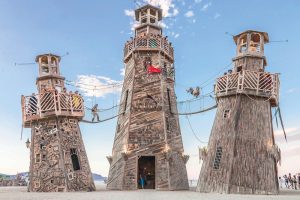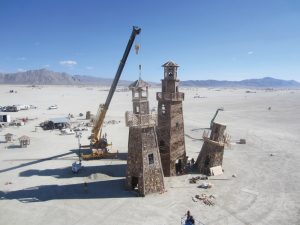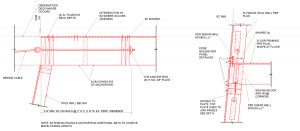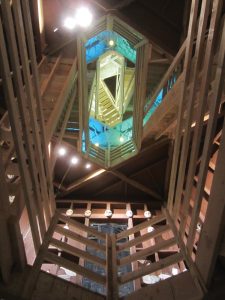A Shining Beacon in the Desert
The Black Rock Lighthouse Service (BRLS) was the tallest independent art installation at Burning Man in 2016. The installation consisted of an array of four main, occupiable lighthouses. Three leaning lighthouses (ranging in height from 15 to 40 feet tall) surround a central, 60-foot tall lighthouse, all interconnected by three 20-foot long cable and rope suspension bridges (Figure 1). Holmes Structures was engaged to assist the artists with the structural design of the project.
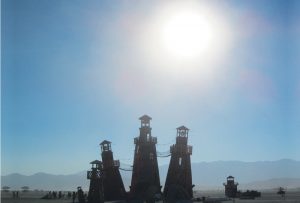 Prelude
Prelude
For the uninitiated, Burning Man’s website describes the festival as “an annual experiment in temporary community dedicated to radical self-expression and radical self-reliance.” It began in 1986 on Baker Beach in San Francisco as a celebration of the summer solstice. After four years, it outgrew its original location and moved to the Black Rock Desert Playa in Nevada, approximately 120 miles north of Reno. Every year, nearly 70,000 people make the pilgrimage and brave the harsh desert conditions to take part in the creation of the temporary artist community named Black Rock City.
As the festival grew over the years, so did the scale and complexity of the festival’s ambitious artworks. Artists are now creating interactive pieces that are dozens of feet tall, weighing thousands of pounds or covering thousands of square feet. Creative structural engineering is essential to protecting the life-safety of festival goers (commonly known as “Burners”) as they experience this massive art while maintaining the aesthetic integrity of the installations.
The Black Rock Lighthouse was conceptualized years ago by the father and son artist team of Max and Jonny Poynton. They envisioned the installation to be, “A crystal-like cluster of Lighthouses inspired by the juxtaposition of creating a destination for fun and shelter by something that is meant to warn you of danger. This adult jungle gym aims to become a destination where participants come to seek shelter, play, meet up with friends, and navigate the inland sea that is the Playa.”
They began assembling a team of artists, carpenters, community organizers, fundraisers, architects, and engineers in late 2015 to start the planning and design of the ambitious project. For four months, the core design team iterated on architectural and structural concepts to help realize the artists’ dream of Lighthouses in the desert.
The project build began in March 2016 and was based at American Steel Studios in Oakland, California. For six months, a crew of up to thirty carpenters, artists, and volunteers labored to prefabricate the majority of the installation into panels that could be easily loaded onto a flatbed truck, shipped to the Black Rock Desert, and assembled on-site.
Though there is no formal building permit review process, the Burning Man Organization has recently started requiring that larger installations such as the Black Rock Lighthouses undergo a third-party peer review. This project used the 2015 International Building Code (IBC) as the reference standard.
Illusion of Danger
One of the artists’ main design objectives was to imbue the installation with a sense of danger. The designers’ challenge was to evoke notions of instability while providing discrete measures to ensure life-safety. The towers had to lean 10 to 25 degrees out-of-plumb without visible wires or braces, so each wall was designed to share load and function together as a single octagonal column unit.
A base “wedge” element was designed to create the tilt in each tower but allowed for an open interior without truly vertical supports. Built-up corner posts with holdown anchors developed the overturning tension into the ground soil anchors and served as panel connection points. The P-Delta effects from the leaning towers were also resisted by suspension bridges aligned with the direction of lean. Conservatism was built into the design by ensuring that the leaning towers could stand up without the need for the suspension bridges. Vice versa, in the case where the soil anchors could fail, the bridges would be sufficient to prevent collapse.
The wedge element that enabled the Lighthouses to lean also allowed the panels for each structure to be fabricated as if the Lighthouses were vertical and assembled upright. The Lighthouses were eventually craned into place and secured to the wedges at appropriate angles (Figure 2), a process prototyped and tested at full-scale, prior to erection, at American Steel using overhead bridge cranes.
The bridge system consisted of two ⅝-inch diameter cables at the top and bottom with salvaged wooden planking between the two bottom cables. Vertical ties were placed along the length of the bridge allowing for the four cables to act together. Each cable was then secured to the towers with an anchor rod and blocking to resolve the horizontal force of the cables back into the tower floor diaphragms (Figure 3).
They were designed to sway and rock as people crossed between observation decks and the open rope-mesh side rails gave clear views of the 30-foot drop below. The narrowness of the bridges (only 18 inches wide) added to the sense of danger and limited the traffic to one-way flow, thereby reducing the design loading. A delicate balance was crafted between the bridges and lighthouses with seemingly opposing structural and aesthetic goals of safety and “death defying” danger.
Prefabrication and Rapid Assembly
There is only a fourteen-day window before the opening of the festival in which structures can be built on site, so completion of a project of this scale is impossible without significant prefabrication for rapid assembly.
Platform framing was chosen for the construction of the Lighthouses for ease of construction and to increase the safety of the building. Wall panels were prefabricated floor to floor, with floor panels sandwiched between wall panels (Figure 3). With the on-site construction reduced to just the connection of joints at the wall panel and floors, the Lighthouses were able to be completed very rapidly with a relatively small crew.
The floors of the Lighthouses were constructed with laminated veneer lumber (LVL) floor joists in a unique “Star of David” pattern. This layout allowed spans for the floor beams to be reduced and keep to the octagonal footprint of the structure. The center of the star allowed for staircase openings and complete vertical circulation for views up into the Lighthouse (Figure 4). Floor sections were fabricated to fit on a flatbed truck instead of transporting an entire diaphragm.
The walls were constructed as traditional shear walls for the lateral force resisting system. Aware that many art installations on the Playa are interactive, and sometimes not interacted with as intended, the Lighthouses were designed with the extra loading of festival-goers potentially climbing up the side. The walls were considered as floors for the leaning towers, and the “Star of David” design offered a direct strut load path to brace the walls out of plane.
Conventional light-framed construction was used, with Simpson Strong-Tie hardware, to maintain simple and uniform construction for the volunteer labor force, some of whom were not carpenters. Prefabrication simplified the geometrically complex construction. Important details in construction could be verified by the engineers and a team of experienced carpenters in the shop. While the goal was the speed of construction on the Playa, it took six months to construct the standardized panels before the installation.
“Evidence-based design” (a.k.a. testing) is a very useful tool for out of the box projects of this nature. Pushing the limits of “artistic license” and mocking up full-scale tests before final implementation provides an added sense of security and confidence in the solutions. In addition to testing the wedge assembly process mentioned previously, the suspension bridges also underwent a similar process prior to installation. With a geometric, nonlinear analysis done as the primary design for the cable suspension bridges, the results were taken to the shop to validate. There it was constructed between temporary support points for full-scale dynamic testing, e.g., jumping up and down by build-crew volunteers. This design process allowed for the quick verification of the safety of the bridges without needing to apply overly conservative loading. Conservative loadings would make it difficult to maintain the slim “rickety rope bridge” aesthetic.
Playa Build
Burning Man has a strict “leave-no-trace” policy for protecting the ground surface at the Playa. In fact, build crews are required to clean up every nail, clip, or noncombustible product remaining after a structure is burned, a tradition at the festival. Therefore, the design could not include excavation or placement of any pre-cast concrete or steel foundations to anchor the structure to the ground. Additionally, the surface of the Playa has very low bearing strength, so spreading the load on the compression side of the Lighthouses was essential.
Foundation tension was addressed with four-foot-long, lightweight, aluminum ground screws made by American Earth Anchor. Justification for their capacity was determined by performing in-situ testing in the first days allowed on site. The base needed to accommodate a flexible anchorage design that could use multiple screws if necessary, depending on the test results. The Penetrator PE-46 Guy headed anchor allowed the pairing of multiple anchors to an eyelet on the bottom of the holdown’s threaded rod. The foundation compression loads were evaluated using a global analysis that treated the fully sheathed wall panels as an equivalent composite octagonal section and distributed the compression forces around the side walls with double base plates across the Playa’s surface.
Flexibility and adjustment in the field proved to be a critical part of the construction process, with Special Inspections provided by the Structural Engineer of Record. The engineering team was on the Playa during the build and able to give instant recommendations for fixes as they occurred. This construction process was a unique experience for the design engineer who rarely has an opportunity to assist directly in construction, thereby providing an extra layer of Quality Assurance. Even though all details were designed as typical, it became apparent when installing the bridges that the connection points were not truly uniform. An engineer needed to be with the crew installing the bridges to ensure design intent was followed.
Mock ups, generous factors of safety, and applying a belt-and-suspenders methodology allowed the project to proceed smoothly through construction, even when changes in the field exceeded specified tolerances. The mix of volunteer labor and a design that was heavily iterative at the early stages led to one of the base wedges constructed with an additional 10 degrees of tilt! Coincidentally, an early iteration of the design happened to assume an extra 10 degrees, and the calculations were not revised when the amount of lean was reduced. This additional factor of safety was a saving grace in the field, allowing the accommodation of the surprise tilt without any changes required.
End of Life
As is customary for many of the large installations at the festival, the Lighthouses were indeed burned. The Burners gathered at a mandated 400-foot radius burn perimeter immediately following the namesake Burning of the Man in a celebratory burn ceremony at 12:30 am on the second to last night of the festival. The structure was purposely built without any heavy timber to help facilitate a full burn to ashes. The Lighthouses still burned for approximately 12 minutes before collapsing onto the Playa. For the curious, the burn video link can be found in the Figure 5 caption.
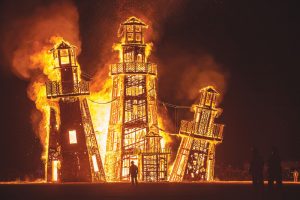
Figure 5. Black Rock Lighthouse burn. Courtesy of Jesse Rather. To view a video, visit https://bit.ly/2JLNaRr.
During the installation, the Lighthouses experienced 60+ mph wind and dust storms, sustained no damage, and served as a place of refuge for festival goers. It was enjoyed by over 70,000 people and served as a true monument on the Playa. With its operable rotating spotlight in the center tower and total of 12 flamethrowers fixed to the tops of the Lighthouses, it was truly a beacon for everyone there. The artwork now only exists in photos and the collective memory of those who experienced it, including the engineers that worked on this once-in-a-lifetime project.▪

